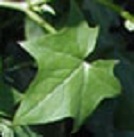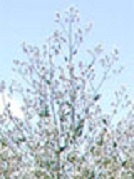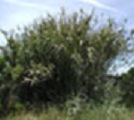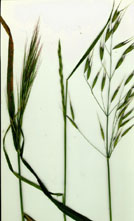
| Friends of Five Creeks |
Common Invasive Plants Along East Bay Creeks
Some non-native plants take over large areas, crowd out the variety of plants that would otherwise flourish, and provide poor habitat for native insects, birds, or other life. The result is a monotonous, impoverished ecosystem. By replacing these invaders with suitable native plants, you can create a low-maintenance, erosion-resistant landscape friendly to wildlife. Try to eliminate these plants before they become established. Prevent erosion if you clear a large stand along creeks.
This is a work in progress!
Vines and vine-like plants:
CAPE OR GERMAN IVY (Senecio mikanoides ) This twining climber from South Africa has bright green, shiny, ivy-like leaves that smell foul when crushed; fluorescent pink young stems; and small yellow flowers in winter. It forms dense masses that shade out all other plants, and spreads rapidly from seeds or fragments. Pull up the plants roots and all (roots are very shallow) and SEAL ALL PARTS in bags. Dispose of these in trash (not compost). Cape ivy breaks very easily, and even a leaf or a bit of stem can take root. Return to pull out new sprouts. Do not grow in house or garden.
Wild cucumber, a similar looking native vine that should be preserved, has slightly hairy, more blue-green leaves; white flowers; and fine curly tendrils. It does not form dense mats.
ALGERIAN and ENGLISH IVY (Hedera). These woody evergreen vines have leathery, dark-green, three-pointed leaves. Algerian ivy, with pinkish stems and less distinct leaf points, is more invasive than English. These ivies are handsome and tough, but they shade out everything else, climb and kill trees, and provide useful habitat only to rats. Wearing gloves (some people are allergic), pull ivy up roots and all -- dense cover can be rolled up like a rug. Don't let it root again. On trees, cut woody stems growing up trees and pull off a few feet, so the ivy above will die.
GIANT BINDWEED, white morning glory (Calystegia sylvatica) is an extremely invasive vine from Southern Europe, with heart-shaped leaves and large white morning-glory flowers. It forms dense, deep networks of fleshy white to pink roots. The vines themselves die back in winter, but in spring come roaring back, covering ground and twining their way up to cover bushes and even trees. Pulling out the aboveground parts is ineffective. One must follow the stems to where they enter the ground (often many feet); roots, which also may extend many feet and go down a couple of feet in several layers, must be dug out or tarped. (Herbicide is not likely to be effective.)
HIMALAYAN BLACKBERRY (Rubus discolor) This common shrub has toothed, divided leaves; long reddish weeping canes that root where they touch ground; pale pink single flowers; edible black berries; and sharp, painful thorns. (Native blackberry, which should be preserved, has dense, almost furry prickles that hardly hurt if you grab them.) Himalayan blackberry provides food for birds and people, and nest spots safe from cats and squirrels. But it takes over large areas if left unchecked. Wearing heavy gloves, cut the canes so you can get close and then dig out the roots, especially woody burls that will sprout new canes. Dispose of where parts cannot root.
EVERGREEN THORNLESS BLACKBERRY (Rubus ulmifolia) is even more invasive than Himalayan blackberry along creeks, and harder to get rid of. As the name implies, it has no thorns. Canes are longer than those of Himalayan blackberry; they can arch or creep almost hidden along the ground. The tips sense water, and root where they touch down, starting a new clump. In this way, they quickly take over large areas, shading out everything else. Roots seem to resprout from even small fragments left in the soil. They must be dug out.
Shrubs and sub-shrubs:
FRENCH BROOM (Genista monspessulana)
COTONEASTER (Cotoneaster franchetti or, less commonly, lacteus or pinnosus)
Salt-loving plants:
PERENNIAL PEPPERWEED (Lepidium latifolium) This pretty, dark green plant with tiny white flowers topping erect, dark green stems is a major threat to Bay wetlands, including salt marshes. It crowds out grasses that feed waterfowl and natives necessary for endangered species such as the clapper rail and salt-marsh harvest mouse. It is very difficult to control, as millions of seeds spread through air and water, and rhizomes creep many feet under the soil. A tiny piece of rhizome can start a new plant, even after long drying. Cut stems before they can flower; dig roots; dispose of everything in plastic bags in garbage. DO NOT COMPOST. Please report East Bay sightings to Friends of Five Creeks, f5creeks@aol.com.
ICE PLANT (Carpobrotus edulis): This low-growing plant has long rooted trailers with succulent, bluish-green leaves often shaded red, and bright pink or yellow flowers. Near salt water, including marshes near creek mouths, it forms dense mats that crowd out native plants that provide food and shelter for such endangered animals like the salt-marsh harvest mouse and California clapper rail. Pull up trailers by hand or with a fork. Dispose of them where they cannot take root.
Grasses and grass-like plants:
GIANT CANE, GIANT REED (Arundo donax) This bamboo-like grass, over 10 feet tall, spreads by rhizomes to form dense colonies that displace all other plants. Arundo takes over streamsides without producing shade needed by fish, and sucks up huge amounts of water. DO NOT PLANT ARUNDO IN YOUR GARDEN. Dig up plants if you can (you may need heavy equipment), or cut stems and immediately apply herbicides directly. Dispose of stems and roots in garbage so they cannot re-root.
PAMPAS GRASS, JUBATA GRASS (Cortaderia selloana, Cortaderia jubata) These tall grasses (6 feet or more) with dramatic white seed plumes crowd out native vegetation without providing food. They also are a fire hazard, and the seed, carried widely on the wind, spreads them widely. Dig up clumps -- they are shallow rooted; often you can pry them out, or remove part at a time. If clumps are large, turn them upside down -- if roots cannot contact soil, they will die. To prevent spread, cut off and bag the plumes. Do not grow these plants in gardens.
SMILO GRASS (Stipa mileacea) is a fairly recent invader that quickly forms clumps 5' tall or more. Recognize it by the bamboo-like jointed stems and delicate, plume-like sprays of seeds. Dig as much root as you can (roots are shallow, but outliers can re-sprout) and if possible bag the plumes, as seed are viable even when they look fresh and new.
VELVET GRASS (Holcus lanatus) is recognizable by coarse, slightly furry, slightly gray-blue leaves and cream-colored seed plumes. Dig or pull it up as fast as you can, and bag the seeds.
Three non-native grasses that displace natives:
RIPGUT BROME, left, can be distinguished from native bromes by the long awn - the thread-like fiber projecting from the seed. In ripgut, the awn is much longer than the seed, 1/2" long or more. As the grass matures, the seeds will be more visible individually, many on each stalk.
ITALIAN RYEGRASS, center, is a shiny-leaved grass whose seeds form a slight zig-zag outline on the sides of the thin, upright flower stalk.
WILD OAT, right, is a tall grass with awns framing heavy, stout individual seeds.
Field weeds
COMMON FIELD WEEDS: Fennel, wild mustard, wild radish, curly dock, and cheeseweed, along with sow thistle and prickly lettuce and Italian, bull, milk, and Canada thistle, are all worth controlling if you can. Pull or dig them out in spring before they can set seed.
CARDOON, ARTICHOKE THISTLE (Cynara cardunculus) Cardoon is dramatic, forming tall fountains of large, gray-green, deeply divided leaves and huge blue-purple thistle-like flowers. It started as a garden vegetable or ornamental. But escaped and gone wild, it develops fierce spines that keep out people and animals. Flowers shed thousands of seeds carried widely on the wind. Wearing heavy gloves, dig up the roots as soon as possible. Don't worry about digging up the wrong plant - all large local thistles are invasive weeds. To prevent spread, cut flowers and buds and dispose of them in sealed bags - even cut, they will form mature seeds. Do not grow cardoon in gardens.
FOR CREEK-FRIENDLY GARDENING: Minimize paving; landscape and grade so that water soaks into soil and doesn't run to storm drains, creeks, and the Bay. Mulch deeply; use compost or other natural fertilizers that release nutrients slowly, so they stay in your yard and don't run off to creeks and the Bay. Control pests with non-toxic alternatives; especially avoid products containing diazinon and chlorpyrifos, which poison aquatic life.



